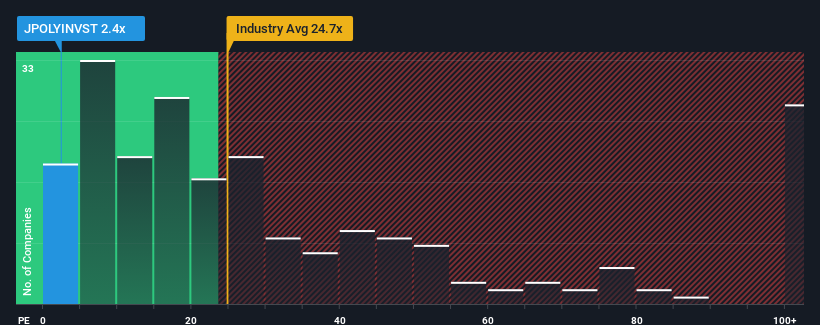- India
- /
- Capital Markets
- /
- NSEI:JPOLYINVST
Jindal Poly Investment and Finance Company Limited (NSE:JPOLYINVST) Surges 27% Yet Its Low P/E Is No Reason For Excitement

Jindal Poly Investment and Finance Company Limited (NSE:JPOLYINVST) shareholders would be excited to see that the share price has had a great month, posting a 27% gain and recovering from prior weakness. The last 30 days bring the annual gain to a very sharp 69%.
Even after such a large jump in price, given about half the companies in India have price-to-earnings ratios (or "P/E's") above 32x, you may still consider Jindal Poly Investment and Finance as a highly attractive investment with its 2.4x P/E ratio. Nonetheless, we'd need to dig a little deeper to determine if there is a rational basis for the highly reduced P/E.
With earnings growth that's exceedingly strong of late, Jindal Poly Investment and Finance has been doing very well. It might be that many expect the strong earnings performance to degrade substantially, which has repressed the P/E. If that doesn't eventuate, then existing shareholders have reason to be quite optimistic about the future direction of the share price.
See our latest analysis for Jindal Poly Investment and Finance

How Is Jindal Poly Investment and Finance's Growth Trending?
In order to justify its P/E ratio, Jindal Poly Investment and Finance would need to produce anemic growth that's substantially trailing the market.
If we review the last year of earnings growth, the company posted a terrific increase of 32%. Still, EPS has barely risen at all from three years ago in total, which is not ideal. So it appears to us that the company has had a mixed result in terms of growing earnings over that time.
Weighing that recent medium-term earnings trajectory against the broader market's one-year forecast for expansion of 25% shows it's noticeably less attractive on an annualised basis.
In light of this, it's understandable that Jindal Poly Investment and Finance's P/E sits below the majority of other companies. It seems most investors are expecting to see the recent limited growth rates continue into the future and are only willing to pay a reduced amount for the stock.
The Key Takeaway
Even after such a strong price move, Jindal Poly Investment and Finance's P/E still trails the rest of the market significantly. We'd say the price-to-earnings ratio's power isn't primarily as a valuation instrument but rather to gauge current investor sentiment and future expectations.
As we suspected, our examination of Jindal Poly Investment and Finance revealed its three-year earnings trends are contributing to its low P/E, given they look worse than current market expectations. Right now shareholders are accepting the low P/E as they concede future earnings probably won't provide any pleasant surprises. Unless the recent medium-term conditions improve, they will continue to form a barrier for the share price around these levels.
A lot of potential risks can sit within a company's balance sheet. Our free balance sheet analysis for Jindal Poly Investment and Finance with six simple checks will allow you to discover any risks that could be an issue.
If P/E ratios interest you, you may wish to see this free collection of other companies with strong earnings growth and low P/E ratios.
If you're looking to trade Jindal Poly Investment and Finance, open an account with the lowest-cost platform trusted by professionals, Interactive Brokers.
With clients in over 200 countries and territories, and access to 160 markets, IBKR lets you trade stocks, options, futures, forex, bonds and funds from a single integrated account.
Enjoy no hidden fees, no account minimums, and FX conversion rates as low as 0.03%, far better than what most brokers offer.
Sponsored ContentNew: Manage All Your Stock Portfolios in One Place
We've created the ultimate portfolio companion for stock investors, and it's free.
• Connect an unlimited number of Portfolios and see your total in one currency
• Be alerted to new Warning Signs or Risks via email or mobile
• Track the Fair Value of your stocks
Have feedback on this article? Concerned about the content? Get in touch with us directly. Alternatively, email editorial-team (at) simplywallst.com.
This article by Simply Wall St is general in nature. We provide commentary based on historical data and analyst forecasts only using an unbiased methodology and our articles are not intended to be financial advice. It does not constitute a recommendation to buy or sell any stock, and does not take account of your objectives, or your financial situation. We aim to bring you long-term focused analysis driven by fundamental data. Note that our analysis may not factor in the latest price-sensitive company announcements or qualitative material. Simply Wall St has no position in any stocks mentioned.
About NSEI:JPOLYINVST
Jindal Poly Investment and Finance
Engages in investment activities in India.
Good value with adequate balance sheet.
Market Insights
Community Narratives




